Panneaux en tôle d'acier sont des matériaux essentiels dans la construction, l'industrie et les applications architecturales. Qu'il s'agisse de construire un toit durable, de créer un extérieur durable ou même d'assembler des machines industrielles, les panneaux en tôle d'acier offrent une résistance, une polyvalence et une longévité inégalées. Dans ce guide complet, nous allons explorer tout ce qu'il y a à savoir sur les panneaux en tôle d'acier : leurs types, leurs processus de fabrication, leurs composants clés, leurs utilisations et même la façon de choisir les meilleurs fournisseurs. L'objectif étant de s'assurer que vous avez une compréhension claire de chaque aspect, ce guide plongera en profondeur dans les détails tout en restant conversationnel et engageant.
Aperçu des panneaux de tôle d'acier
Les panneaux de tôle d'acier sont des tôles plates ou ondulées fabriquées à partir de différents types d'acier, utilisés dans diverses applications en raison de leur solidité, de leur résistance à la corrosion et de leur aptitude au formage. Ils sont disponibles en différentes épaisseurs et finitions en fonction de l'usage auquel ils sont destinés, y compris les tôles galvanisées, peintes et les tôles d'acier brut. Les panneaux de tôle d'acier sont fabriqués à l'aide d'une série de procédés faisant appel à des poudres métalliques et à des machines de laminage pour créer différents profils, tels que les tôles ondulées, les panneaux à joint debout et les tôles plates. La composition de l'acier utilisé peut varier, ce qui influe sur la résistance, la flexibilité et la longévité du panneau.
Principaux détails des panneaux de tôle d'acier :
- Durabilité : Les panneaux en acier durent des décennies et résistent aux conditions climatiques, à la corrosion et à l'usure mécanique.
- Polyvalence: Convient pour les toitures, les bardages, la construction et même les processus de fabrication.
- Facilité de personnalisation : Disponibles en différentes épaisseurs, tailles et finitions pour répondre aux besoins de différents projets.
- Faible entretien: Avec un minimum d'entretien, les panneaux en tôle d'acier conservent leur apparence et leur intégrité structurelle.
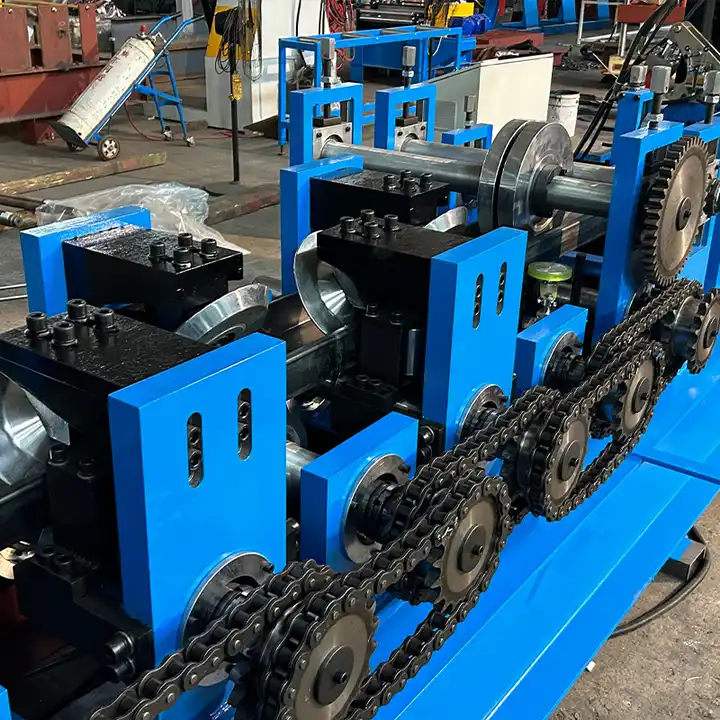
Types de panneaux de tôle d'acier
Lorsque l'on choisit des panneaux en tôle d'acier, il est essentiel de comprendre les différents types disponibles et ce qui les rend uniques. Vous trouverez ci-dessous une présentation des types de panneaux en tôle d'acier les plus courants.
Types de panneaux de tôle d'acier courants
| Type de tôle d'acier | Description | Caractéristiques principales |
|---|---|---|
| Tôles d'acier galvanisé | Revêtu d'une couche de zinc pour éviter la rouille. Idéal pour une utilisation en extérieur où la résistance à l'humidité est essentielle. | Résistant à la corrosion, durable et rentable |
| Panneaux de tôle ondulée | Feuilles ondulées souvent utilisées pour la couverture ou le bardage. Leur conception leur confère une résistance et une rigidité accrues. | Solide, léger et facile à installer |
| Feuilles d'acier inoxydable | Fabriquées à partir d'alliages d'acier contenant du chrome, ces tôles offrent une résistance accrue à la corrosion, en particulier dans les environnements difficiles. | Grande durabilité, résistance à la corrosion et esthétiquement agréable |
| Panneaux en acier aluminé | Tôles d'acier revêtues d'un alliage d'aluminium et de silicium. Ces panneaux offrent une excellente résistance à la chaleur et sont souvent utilisés dans les applications automobiles et industrielles. | Résistant à la chaleur, léger et durable |
| Tôles d'acier laminées à froid | Laminées à froid pour obtenir des finitions lisses et des dimensions précises, ces tôles sont utilisées dans des applications haut de gamme exigeant une mise en forme et un façonnage précis. | Finition lisse, mise en forme précise, idéal pour le cintrage |
| Panneaux d'acier laminés à chaud | Créées par chauffage et laminage, ces feuilles sont plus malléables et plus abordables. Elles sont utilisées pour des applications structurelles où une finition précise n'est pas cruciale. | Abordable, malléable et idéal pour les applications à grande échelle |
| Acier électro-galvanisé | Ces feuilles subissent un processus de galvanisation pour assurer un revêtement de zinc uniforme. Elles sont souvent utilisées dans les appareils électroménagers et les composants automobiles. | Revêtement uniforme, résistant à la corrosion et visuellement attrayant |
| Tôles d'acier perforées | Feuilles percées de trous à des fins de ventilation, de filtration ou de décoration. Largement utilisées dans les conceptions architecturales et les environnements industriels. | Débit d'air, modèles personnalisables et applications polyvalentes |
| Panneaux d'acier revêtus de couleur | Tôles d'acier peintes ou revêtues de diverses couleurs pour l'esthétique. Souvent utilisées dans des projets architecturaux où l'attrait visuel est aussi important que la fonctionnalité. | Esthétique, résistant à la corrosion et personnalisable |
| Tôles d'acier résistant aux intempéries | Également connus sous le nom d'acier Corten, ces panneaux acquièrent avec le temps une patine semblable à la rouille, qui les protège contre la corrosion. Ils sont couramment utilisés dans les applications extérieures. | Patine rouille auto-cicatrisante, peu d'entretien et résistance aux intempéries |
Chacun de ces types de tôles d'acier présente des avantages et des inconvénients distincts. Il est donc essentiel de choisir le bon type de tôle en fonction des besoins spécifiques de votre projet, tels que l'environnement, le budget et les exigences en matière de conception.
Guide des panneaux de tôle ondulée
Les panneaux de tôle d'acier ondulée se distinguent par leur forme ondulée, qui leur confère une plus grande solidité et les rend idéaux pour les toitures, les bardages et même certaines structures. Leur conception ondulée améliore la rigidité tout en maintenant le matériau léger et facile à installer.
Avantages des tôles ondulées
- Augmentation de la force : Le processus d'ondulation rend l'acier plus solide en répartissant le poids plus uniformément sur le panneau.
- Résistance aux intempéries : Ces feuilles sont souvent galvanisées ou peintes, ce qui leur permet de résister aux environnements extérieurs difficiles, notamment aux vents violents et aux fortes pluies.
- Le rapport coût-efficacité : Par rapport à d'autres matériaux tels que les tuiles ou les bardeaux d'asphalte, la tôle ondulée est relativement abordable pour les applications à grande échelle.
- Simplicité d'installation : Grâce à leur légèreté et à leur flexibilité, les panneaux en tôle ondulée sont faciles à manipuler, ce qui réduit le temps d'installation et les coûts de main-d'œuvre.
Processus de travail Panneaux en tôle d'acier
Le processus de production des panneaux en tôle d'acier comporte plusieurs étapes, depuis le métal brut jusqu'au produit final utilisé dans la construction. Les étapes suivantes décrivent le processus général :
1. Sélection des matières premières
Les panneaux en tôle d'acier commencent généralement par le choix de l'alliage d'acier approprié. Ces matériaux comprennent souvent de l'acier à faible teneur en carbone pour sa maniabilité ou de l'acier inoxydable pour une meilleure résistance à la corrosion. Divers additifs tels que le chrome, le zinc ou l'aluminium peuvent être utilisés en fonction des propriétés souhaitées.
2. Création de poudres métalliques
Les poudres métalliques sont souvent utilisées pour des revêtements spéciaux, tels que la galvanisation. Ces poudres sont obtenues en broyant des métaux en fines particules, qui peuvent ensuite être appliquées à la surface de la tôle d'acier pour améliorer la résistance à la corrosion ou à la chaleur.
3. Laminage et formage
L'acier brut est chauffé à haute température et passé dans des laminoirs pour obtenir l'épaisseur souhaitée. Ce processus peut être réalisé à chaud (pour la malléabilité) ou à froid (pour la précision).
4. Ondulation et mise en forme
Pour créer des panneaux ondulés, la tôle d'acier plate est pressée en motifs ondulés à l'aide de machines spécialisées. Ce façonnage ajoute de la résistance et de la rigidité, ce qui rend la tôle adaptée à des utilisations structurelles telles que la couverture et le bardage.
5. Revêtement et finition
Une fois les panneaux formés, des finitions supplémentaires, telles que la galvanisation ou la peinture, sont appliquées. Ces revêtements améliorent la résistance de l'acier à la corrosion, aux conditions climatiques et à l'usure au fil du temps.
6. Contrôle de la qualité
Avant d'être expédiés, les panneaux sont soumis à des contrôles de qualité stricts afin de s'assurer qu'ils répondent aux spécifications requises en matière d'épaisseur, de résistance et de finition. Les panneaux qui ne satisfont pas aux contrôles de qualité sont recyclés ou retravaillés.
Principaux composants des panneaux de tôle d'acier et leurs fonctions
Les panneaux en tôle d'acier sont constitués de divers éléments clés qui déterminent leurs performances dans les applications de construction et de fabrication. Comprendre la fonction de chaque composant peut aider à choisir le bon type de panneau d'acier pour votre projet.
Les composants clés et leurs fonctions
| Composant | Fonction |
|---|---|
| Alliage d'acier | Fournit la résistance, la flexibilité et la durabilité du matériau de base. La composition de l'alliage (carbone, chrome, etc.) influence ces caractéristiques. |
| Revêtement Zinc/Aluminium | Prévient la rouille et la corrosion des panneaux galvanisés ou aluminisés, prolongeant ainsi la durée de vie de la tôle dans des conditions extérieures. |
| Additif de chrome | Utilisé dans les panneaux en acier inoxydable pour la résistance à la corrosion, en particulier dans les environnements difficiles. |
| Ondulations | Ajoute de la rigidité structurelle et de la résistance sans augmenter le poids de la feuille, idéal pour les toitures et les bardages. |
| Revêtement de peinture | Il offre à la fois un attrait esthétique et une protection supplémentaire contre les intempéries et l'usure. |
| Perforations | Dans les tôles perforées, des trous sont ajoutés pour la ventilation, la filtration ou la décoration. |
-
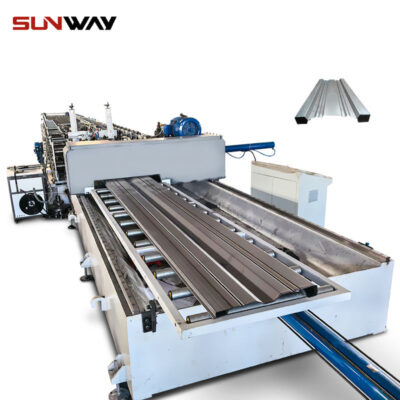 Petit pain de conseil de chariot formant la machine
Petit pain de conseil de chariot formant la machine -
 Machine de formage de bornes d'extrémité de glissières de sécurité pour autoroutes
Machine de formage de bornes d'extrémité de glissières de sécurité pour autoroutes -
 Profileuse pour poteaux d'autoroute U/C
Profileuse pour poteaux d'autoroute U/C -
 Machine de formage de rouleaux de glissières de sécurité à 2 vagues pour autoroutes
Machine de formage de rouleaux de glissières de sécurité à 2 vagues pour autoroutes -
 Machine de formage de rouleaux de glissières de sécurité à 3 vagues
Machine de formage de rouleaux de glissières de sécurité à 3 vagues -
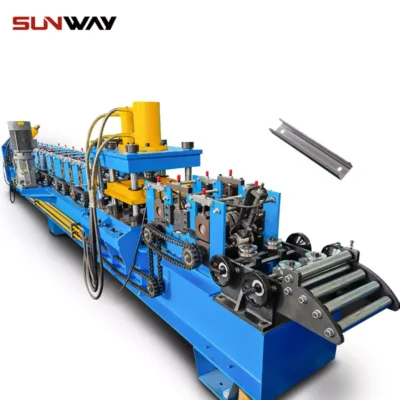 Section C renforçant la machine de formage de rouleaux de poteau de support de stockage Omega
Section C renforçant la machine de formage de rouleaux de poteau de support de stockage Omega -
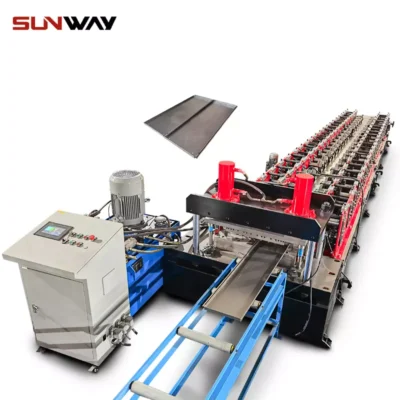 Plaque de boîte en acier faisant la machine de formage de rouleaux
Plaque de boîte en acier faisant la machine de formage de rouleaux -
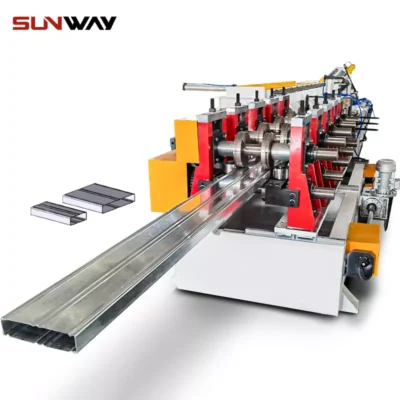 Petit pain en acier de poutre en caisson formant la machine pour la colonne d'étagère
Petit pain en acier de poutre en caisson formant la machine pour la colonne d'étagère -
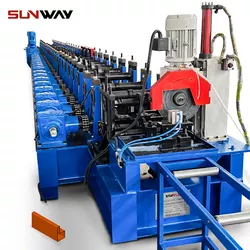 Pallet Racking Step Beam P Beam Roll Machine de formage
Pallet Racking Step Beam P Beam Roll Machine de formage
Vitesse et efficacité des machines dans la production de panneaux de tôle d'acier
L'efficacité de la production de panneaux en tôle d'acier dépend des machines utilisées, notamment de la vitesse et de la précision avec lesquelles le matériau peut être traité. Voici un tableau détaillé des vitesses des machines et de l'efficacité de la production.
Vitesse et efficacité de la machine
| Type de machine | Vitesse (m/min) | Efficacité (feuilles par heure) | Mieux adapté pour |
|---|---|---|---|
| Machine à onduler | 20-60 m/min | 1000 feuilles/heure | Production de panneaux ondulés |
| Laminoir à froid | 10-30 m/min | 500-800 feuilles/heure | Tôles d'acier laminées à froid de haute précision |
| Laminoir à chaud | 60-100 m/min | 1200 feuilles/heure | Production à grande vitesse de tôles laminées à chaud malléables |
| Machine d'enduction (galvanisation) | 5-15 m/min | 400-600 feuilles/heure | Application du revêtement de zinc/aluminium |
| Machine de perforation | 15-40 m/min | 700-900 feuilles/heure | Création de tôles d'acier perforées |
Le type de machine et sa vitesse influencent l'efficacité de la production, le coût et la qualité finale des panneaux de tôle d'acier.
Paramètres mécaniques personnalisés pour Panneaux en tôle d'acier
La personnalisation des panneaux en tôle d'acier nécessite l'ajustement de paramètres mécaniques spécifiques en fonction de l'application. Le tableau suivant présente les différents paramètres personnalisables et leur importance.
Paramètres mécaniques personnalisés
| Paramètres | Description |
|---|---|
| Épaisseur (mm) | Les feuilles plus épaisses offrent plus de résistance et de durabilité, mais elles sont plus lourdes et plus difficiles à installer. |
| Longueur (m) | Les longueurs sur mesure permettent une adaptation précise à des projets spécifiques, réduisant ainsi les déchets et le temps d'installation. |
| Largeur (m) | Les panneaux plus larges couvrent une plus grande surface avec moins de joints, ce qui réduit le risque de fuites dans les applications de toiture. |
| Épaisseur du revêtement (µm) | L'épaisseur de la couche de zinc, d'aluminium ou de peinture influe sur la résistance à la corrosion et la longévité du panneau. |
| Profondeur de l'ondulation (mm) | Des ondulations plus profondes augmentent la résistance mais peuvent affecter l'aspect visuel et la flexibilité générale du panneau. |
| Taille de la perforation (mm) | Pour les tôles perforées, la taille et le motif des trous peuvent être personnalisés à des fins de ventilation ou de décoration. |
Applications des panneaux de tôle d'acier
Les panneaux de tôle d'acier sont utilisés dans une grande variété d'industries, de la construction à la fabrication. Le tableau ci-dessous présente quelques applications courantes.
Applications et utilisations
| Application | Description |
|---|---|
| Toiture et bardage | Les panneaux d'acier sont souvent utilisés pour les toitures et les bardages en raison de leur solidité, de leur résistance aux intempéries et du peu d'entretien qu'ils nécessitent. |
| Industrie automobile | Les panneaux en acier à haute résistance sont utilisés dans la construction automobile pour les panneaux de carrosserie, les pièces de châssis et d'autres composants structurels. |
| Équipement industriel | Les tôles d'acier sont utilisées pour fabriquer des pièces de machines, notamment des boîtiers, des carters et d'autres composants nécessitant résistance et précision. |
| Projets architecturaux | Les tôles perforées et les tôles à revêtement coloré sont très appréciées dans les projets architecturaux en raison de leur attrait esthétique et de leur fonctionnalité structurelle. |
| Bâtiments agricoles | Les panneaux en tôle ondulée sont largement utilisés dans la construction de granges, de hangars et de bâtiments de stockage en milieu agricole. |
| Systèmes CVC | Les tôles d'acier perforées sont utilisées dans les systèmes CVC pour la filtration de l'air, les conduits et la ventilation. |
| Milieux marins | Les tôles en acier résistant aux intempéries ou en acier inoxydable sont utilisées dans les applications marines en raison de leur capacité à résister aux environnements difficiles et salins. |
| Appareils électroménagers et électroniques | Les tôles d'acier électro-galvanisées sont couramment utilisées pour la fabrication d'appareils tels que les réfrigérateurs, les machines à laver et les boîtiers d'appareils électroniques. |
Installation, fonctionnement et entretien des panneaux de tôle d'acier
Les panneaux de tôle d'acier doivent être installés, utilisés et entretenus correctement pour garantir leur longévité et leurs performances optimales. Vous trouverez ci-dessous des lignes directrices pour chaque aspect.
Installation, fonctionnement et entretien
| Aspect | Lignes directrices |
|---|---|
| Installation | Veiller au bon alignement, à l'espacement et à la bonne fixation pour éviter les fuites et les faiblesses structurelles. Utiliser les outils appropriés pour couper et ajuster les panneaux. |
| Fonctionnement | Une fois installés, les panneaux nécessitent peu de surveillance opérationnelle, mais il est recommandé de procéder à des inspections régulières pour détecter les signes d'usure ou d'endommagement. |
| Maintenance | Nettoyez régulièrement les panneaux pour éliminer les débris et la saleté. Vérifiez l'absence de rouille ou de corrosion sur les panneaux galvanisés ou revêtus et réparez-les si nécessaire. |
Fournisseurs et gamme de prix des panneaux de tôle d'acier
Le choix du bon fournisseur est essentiel pour obtenir des panneaux de tôle d'acier de haute qualité à un prix raisonnable. Voici un tableau présentant quelques fournisseurs et leurs gammes de prix.
Fournisseurs et fourchette de prix
| Fournisseur | Localisation | Fourchette de prix (par mètre carré) | Produits proposés |
|---|---|---|---|
| Acier BlueScope | Australie | $5 – $15 | Panneaux en acier galvanisé, coloré et ondulé |
| Tata Steel | Inde | $4 – $12 | Tôles ondulées, aluminées et laminées à froid |
| ArcelorMittal | Mondial | $6 – $18 | Tôles d'acier inoxydable, d'acier résistant aux intempéries et d'acier perforé |
| POSCO | Corée du Sud | $7 – $20 | Tôles d'acier laminées à chaud, laminées à froid et revêtues de couleur |
| Nippon Steel Corporation | Japon | $8 – $22 | Acier à haute résistance, acier inoxydable et tôles électro-galvanisées |
Comment choisir le bon fournisseur de panneaux de tôle d'acier
Le choix d'un fournisseur fait intervenir plusieurs facteurs, tels que le prix, la qualité du produit et la réputation du fournisseur. Voici un guide sur les éléments à prendre en compte lors du choix d'un fournisseur de panneaux de tôle d'acier :
Choisir le bon fournisseur
| Critères | Explication |
|---|---|
| La qualité des produits | Vérifiez la qualité de l'acier, des revêtements et des options de finition. Recherchez des certificats tels que ISO 9001, qui confirment le respect des normes de qualité par le fournisseur. |
| Tarification | Comparez les prix de plusieurs fournisseurs, mais veillez à ce que les prix les plus bas ne compromettent pas la qualité. Cherchez à obtenir des remises en cas d'achats en grandes quantités. |
| Délais et disponibilité | Assurez-vous que le fournisseur est en mesure de respecter les délais de votre projet et qu'il dispose de stocks suffisants. Les retards de livraison peuvent faire échouer les projets. |
| Service client | Un fournisseur fiable offre un bon service à la clientèle, un support technique et une assistance après-vente, vous aidant à l'installation, à la personnalisation et à la maintenance. |
| Pratiques de durabilité | Si la responsabilité environnementale est importante pour votre projet, optez pour des fournisseurs qui pratiquent une production durable, y compris le recyclage et la réduction des émissions. |
Avantages et limites des panneaux en tôle d'acier
Si les panneaux en tôle d'acier offrent de nombreux avantages, ils présentent également certaines limites. Voici un tableau comparatif mettant en évidence les avantages et les inconvénients.
Avantages et limites des panneaux en tôle d'acier
| Avantages | Limites |
|---|---|
| Durabilité | Susceptible de se bosseler dans des conditions extrêmes telles que la grêle ou les chocs violents |
| Résistance à la corrosion (avec revêtements) | Peut se corroder si les revêtements sont rayés ou endommagés |
| Léger et solide | Peut être bruyant en cas de forte pluie ou de grêle s'il n'est pas correctement isolé. |
| Polyvalence en matière de conception et de personnalisation | L'installation doit être effectuée par un professionnel afin d'éviter les dommages dus à la manipulation ou à une mauvaise fixation. |
| Résistance au feu | La conductivité thermique peut être un problème dans les environnements à haute température, ce qui nécessite une isolation appropriée. |
| Faible entretien | Coût initial plus élevé que celui des matériaux traditionnels tels que les bardeaux d'asphalte. |
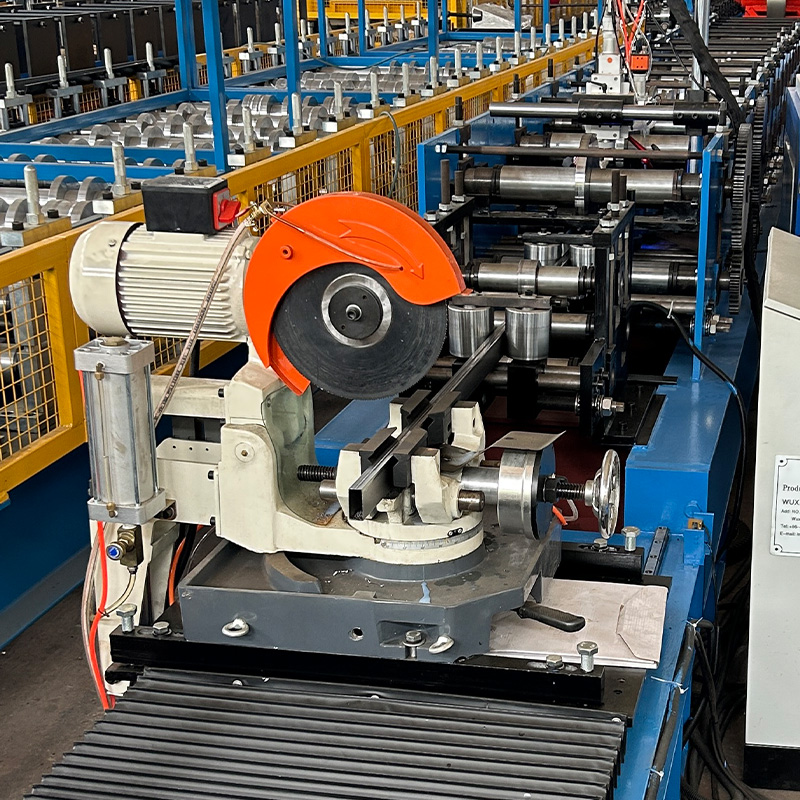
FAQ
| Question | Réponse |
|---|---|
| Quelle est la durée de vie des panneaux en tôle d'acier ? | Les panneaux en tôle d'acier peuvent durer entre 40 et 70 ans, en fonction du type de revêtement, des facteurs environnementaux et d'un entretien adéquat. |
| Les panneaux en tôle d'acier sont-ils écologiques ? | Oui, les panneaux en acier sont recyclables et de nombreux fabricants utilisent des pratiques respectueuses de l'environnement, notamment l'utilisation d'acier recyclé dans la production. |
| Les panneaux en tôle d'acier peuvent-ils être peints ? | Oui, les panneaux d'acier peuvent être colorés au cours de la production ou peints ultérieurement pour s'adapter aux préférences esthétiques. |
| Comment prévenir la rouille sur les panneaux en tôle d'acier ? | L'utilisation de panneaux galvanisés ou revêtus et un entretien adéquat, tel que le nettoyage et la réparation des rayures, peuvent contribuer à prévenir la rouille. |
| Les panneaux en tôle d'acier sont-ils bons pour l'isolation ? | L'acier n'est pas un bon isolant en soi, mais l'ajout d'une isolation adéquate sous les panneaux peut améliorer les propriétés d'isolation thermique et acoustique. |
| Combien coûtent les panneaux en tôle d'acier ? | Les prix varient, mais se situent généralement entre $4 et $22 par mètre carré, en fonction du type d'acier, de l'épaisseur et de tout revêtement ou traitement supplémentaire. |
| Les panneaux en tôle d'acier peuvent-ils être utilisés dans les zones côtières ? | Oui, mais il est recommandé d'utiliser de l'acier inoxydable ou des panneaux à revêtement spécial, comme l'acier résistant aux intempéries, afin de résister à l'environnement marin salin et corrosif. |
Conclusion
Panneaux en tôle d'acier sont une solution incroyablement polyvalente et durable pour une large gamme d'applications, de la construction aux utilisations industrielles. Grâce aux différents types, revêtements et options de personnalisation disponibles, ils offrent à la fois fonctionnalité et attrait esthétique. Que vous recherchiez des matériaux de couverture rentables ou des solutions architecturales haut de gamme, la compréhension des types, des processus de production et des caractéristiques de performance des panneaux de tôle d'acier vous aidera à prendre une décision éclairée pour votre projet.
